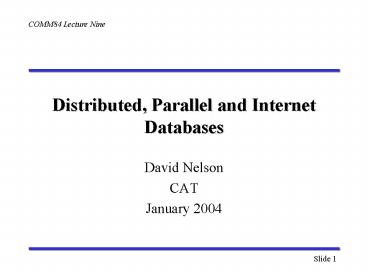Distributed, Parallel and Internet Databases - PowerPoint PPT Presentation
1 / 21
Title:
Distributed, Parallel and Internet Databases
Description:
a DDBS is usually a single application distributed over various sites ... Optimal size depends on range of cost-effective granule sizes, and workload characteristics ... – PowerPoint PPT presentation
Number of Views:92
Avg rating:3.0/5.0
Title: Distributed, Parallel and Internet Databases
1
Distributed, Parallel and Internet Databases
- David Nelson
- CAT
- January 2004
2
Contents
- Definitions
- Distributed Database Systems
- Homogeneous and Heterogeneous Systems
- Federated DBMS Systems
- X/OPEN DTP Standard
- Internet Databases
- Client/Server Architectures, advantages and
disadvantages - Web Database Approaches
- Further Reading
3
Definitions
- Distributed Database System
- the ability of the DDBS users to run applications
at each node - Parallel Database System
- black box nodes
- Federated Database System
- a DDBS is usually a single application
distributed over various sites - a FDBS is a cooperating multiple system
4
Traditional Architecture
- Traditional Database Systems are based on a
two-tier client-server architecture
- User interface
- Main business and data processing logic
Client
Database Server
- Server-side validation
- Database access
5
Distributed Database Systems
- System needs facilities to be able to
- perform distributed query optimization
- manage distributed transactions
- manage data replication
- Homogeneous DDBS simplest case
- several sites, each running applications on same
DBMS with same schema and transactions - location transparency
- can communicate over large distances, and are
autonomous
6
Heterogeneous DDBMS
- Several existing databases (using different
DBMSs) linked into a single system - Problems
- variation in costs of operation between sites
- some operations may not be available at some
sites - some DBMSs cannot read records of others
- varying base types
- Requesting site must
- have detailed knowledge of operation of remote
system - assume remote system has only rudimentary
functionality - make programmer do query composition by hand
7
Federated DBMS
- A collection of independently managed,
heterogeneous database systems - allow partial and controlled sharing of data
without affecting existing applications
Federated schema
Federated to local schema mapping
Local schema
Federated schema
Federated to local schema mapping
Local schema
8
Client-Server Systems
- DB applications can be classified according to
granularity of database accesses - coarse grained - transactions which access large
volumes of data, e.g. decision support, large
scientific apps - medium grained - access groups of up to several
dozens of records, e.g. order entry, convential
commercial apps) - fine grained - typically navigational, accessing
small portions of linked records, e.g. CAD, CASE
etc.
9
Coarse Grained Systems
- Few large interactions with database
- will benefit from parallel execution of queries
on the server - may be necessary to bring back useful data to
client for sequential processing
Application (on client)
Application (on client)
Database server
10
Fine Grained Systems
- Often advantageous to request large data
transfers from server to local cache - high locality of reference gives good performance
- built-in inter-query parallelism
application client database (cache)
application client database (cache)
Database server
11
Data Placement
- Two aims in spreading the data over the nodes
- balance load between nodes (or disks)
- minimize data transfers between nodes
- Aims are incompatible - need a compromise
- place frequently co-referenced records on the
same node - ensure groups and evenly distributed between
nodes - Optimal size depends on range of cost-effective
granule sizes, and workload characteristics
12
Parallel Database Architectures
- Classified according to the elements that are
shared - Shared Memory Systems
- Shared Disk Systems
- Shared Nothing Systems
- Hybrid Systems
13
Shared Memory Systems
- All processors share disks and main memory
- Inter-query parallelism achieved by adding more
processors - intra-query difficult
- Does not scale well beyond 20 processors
- Many commercial systems (Oracle, DB2, Ingres)
...
processor
processor
processor
Memory
...
14
Shared Disk Systems
- Consists of nodes (processors and memory) and a
pool of shared disks - Easy to port existing systems
- by mapping transactions to single nodes (gives
inter-query parallelism) - Limited by volume of traffic on communications
network
...
Processor memory
Processor memory
Processor memory
...
15
Shared Nothing Systems
- Nodes linked by a communications network
- Data allocated to nodes
- every query must be parallelised
- load balancing is difficult, as data is
statically distributed - Heavily reliant on intra-query parallelism
- e.g. ICL Goldrush
...
Processor memory
Processor memory
Processor memory
16
Hybrid Systems
- May have a top-level shared disk architecture
- Individual nodes are themselves shared memory
systems - Good compromise between load balancing and
scalability
17
Web Architecture
- Need for enterprise scalability causes problems
which can be solved by a three-tier architecture
- User interface
Client
Application Server
- Business logic
- Data processing logic
- Server-side validation
- Database access
Database Server
18
Web as a Database Platform
- Advantages
- DBMS advantages
- Simplicity
- Graphical User Interface
- Standardization
- Cross-platform support
- Transparent network access
- Scalable deployment
- Innovation
19
Web as a Database Platform
- Disadvantages
- Reliability
- Security
- Cost
- Scalability
- Limited HTML Functionality
- Statelessness
- Bandwidth
- Performance
- Immaturity of development tools
20
Approaches
- CGI
- Server Side Includes
- HTTP Cookies
- API (non-CGI gateways)
- ODBC
- Java (JDBC, JSQL, JRB)
- JavaScript, JScript
- Microsoft Active Platform (ASP, ADO, ActiveX)
- PHP (Hypertext Preprocessor)
21
Further Reading
- Connolly and Begg, Database Systems, chapters 22,
28, 29, and appendix H. - Ozsu and Valduriez, Principles of Distributed
Database Systems, 2nd edition - everything you ever wanted to know about
distributed database systems - Chaudri and Zicari, Succeeding with Object
Databases, 2001. - Elmasri, Fundamentals of Database Systems, 3rd
edition, 1999.






























